This article was co-authored by Eric Christensen, DPT. Eric Christensen is a Physical Therapist based in Chandler, Arizona. With over a decade of experience, Eric works in both orthopedic and neurological fields and specializes in custom orthotic prescription and casting, vestibular reprogramming, and manual therapy. He holds a Bachelor’s degree in Exercise Science with a focus in Sports Medicine from Colorado State University and a Doctor of Physical Therapy from Regis University. In practice, Eric takes a developmental approach to rehabilitation utilizing the Selective Functional Movement Assessment. He uses functional movement patterning and manual therapy to return patients to prior levels of function.
There are 10 references cited in this article, which can be found at the bottom of the page.
wikiHow marks an article as reader-approved once it receives enough positive feedback. In this case, 100% of readers who voted found the article helpful, earning it our reader-approved status.
This article has been viewed 820,130 times.
Lower back disorders are painfully common. In the United States, back pain is the single most common cause of job-related disability.[1] Stretches can help keep your lower back healthy. However, because the area is sensitive and prone to injury, stretching properly requires good form.
Steps
Standing Back Stretch
-
1Stand erect, relaxed, with your hands at your sides. Breathe deeply in preparation for your stretch - this will help oxygenate your muscle tissue, promoting healing and minimising lactic acid formation, which causes soreness.
- Find a stretching area where you have privacy and are unlikely to be surprised. Although unlikely, a jerking motion while stretching can hurt your back.
-
2Bend forward slowly. Allow your arms to relax. They should drop and hang below you.
- Pay attention to the way your lower back feels. It's normal to feel light tension like you might feel in any other stretch. If you encounter any pain while leaning forward, stop immediately and try a different stretch.
Advertisement -
3Ease forward until you feel slight "stretching" tension in the lower back. At this point, stop leaning forward and maintain your position.
- Be comfortable--do not bend to the point of feeling pain.
- Do not bounce to get farther downward.
-
4Hold the position for ten seconds. You should feel your lower back begin to stretch.
- Because you're staring at your feet, it can be tempting to try to touch them. Don't do this - you can hurt your back by stretching it too far.
-
5Raise up to a standing position. Begin to lean backwards slowly.
- It may help to maintain your balance if you bend your knees slightly.
-
6Gently bend backward with your hands on your hips. As always, do not bend to the point of feeling pain[2] .
-
7Hold this position for ten seconds. You should feel a slight stretch in your lower back and/or the front of your hips.
-
8Gently return to standing erect. Repeat these stretches 2-3 more times or as needed.
Supine Knee-to-Chest Stretch
-
1Lay on your back on a carpeted floor or exercise mat. Bend your knees and keep your feet flat on the floor.[3]
- This stretch is great for people who already have lower back pain. It stretches the lower back along with supporting muscles in the hips and glutes.
-
2Keeping your leg bent, slowly bring one thigh up in the direction of your chest. Grasp the leg with both hands under the knee. Gently pull the leg in towards your body.
- You should feel a gentle stretch in your lower back, glute, and or hip. The lower back is a complex structure comprised of many intertwined muscles and nerves - improving hip and glute flexibility can have a positive effect on back pain.[4]
-
3Hold the leg against your chest for about 30 seconds. Keep your other leg in a comfortable position - usually against the floor, either straight or bent at the knee.[5]
- To add a hip-flexing element to the stretch, use your hands to rotate your leg by gently pulling your shin across your body.
-
4Ease your leg back to a resting position, then repeat for the other leg. Repeat 2-3 times per leg for a thorough, even stretch.
Cat - Cow Stretch
-
1Lower yourself onto all fours on an exercise mat. Keep your arms and thighs at approximately right angles to your torso. Don't let your knees slide behind you as if you were about to do a knees-down pushup.[6]
-
2Breathing deeply, arch your back like a cat. Hold this position for fifteen to thirty seconds.[7]
- You should feel a light stretch in your lower back. You can fine-tune the stretch by making small adjustments in the way you arch your back.
- Because you utilise your abdominal and back muscles to arch your back, this stretch doubles as a core-strengthening exercise. It's normal to feel a very light "burn" in the back and abdominals while performing this stretch.
-
3Gently return to resting position. Allow your torso to bend toward the floor, forming a downward curve. Hold this position for fifteen to thirty seconds, feeling a light stretch in the lower back.
-
4Repeat stretch as needed. An average cat-camel session consists of two to four repetitions.
- Because of its core-strengthening properties, the cat-cow is a good addition to a well-rounded core workout.
Yoga Poses
-
1Choose the pose that's right for you. A wide variety of yoga poses that stretch the lower back exist. Most should be safe for healthy people. However, if you have a back injury such as a herniated disc, some stretches may worsen your condition. Poses that involve bending or twisting at the waist, especially while bearing weight, can be particularly harmful. If you are unsure about a pose, consult a doctor or physical therapist. Below are a few common yoga poses for the back.
-
2Try downward-facing dog. This is a well-known yoga pose that serves as a great all-over stretch and core-strengthening exercise. Also, it stretches the back extensor muscles, which help support the lower back and stabilise the spine[8] .
- Begin on all fours, with your hands slightly in front of your shoulders.
- Press back on the floor with your hands to lift your body into the air, straightening your knees as you go.
- Form an upward-facing V with your body, with your glutes as the highest point. If you can, try to press your heels to the floor for a great calf stretch.
- Hold the position for about twenty seconds, repeating several times.
-
3Give child's pose a try. This relaxing stretch provides great back flexibility. It also serves as a fantastic hip, shoulder, and chest stretch.
- Begin on all fours. Stretch your arms out in front of you, allowing your face to lower to a position near the floor.
- Gently sit back. Allow your glutes to rest just above your heels. As you ease back, feel the gentle stretch in your lower back.
- Hold this position for twenty to thirty seconds, repeating as needed.
-
4Snake into the cobra pose. This targeted back stretch allows a great deal of control - you decide how much you want to stretch your back. It's also a good back strength-builder.[9]
- Begin by lying face down on the floor. Stretch your feet back so that the tops of your feet are touching the floor.
- Place your palms on the floor at chest level. Pushing down with your thighs and hips, use your hands to slowly lift your upper body up.
- Continue to push your upper body up until you find a comfortable stretching point. Pull your shoulders back and keep your hips narrow through your stretch.
- Hold the stretch for fifteen to thirty seconds, repeating as needed.
- To add an extra back-strengthening dimension to the exercise, use your back muscles to assist your arms when you raise your lower body.
References
- ↑ http://www.ninds.nih.gov/disorders/backpain/detail_backpain.htm
- ↑ https://www.orthocarolina.com/media/back-pain-7-stretches-you-can-do-from-your-desk-chair
- ↑ https://www.physio-pedia.com/Single_Knee_to_Chest_Stretch
- ↑ David Schechter, MD. Family Medicine Practitioner. Expert Interview. 15 July 2020.
- ↑ https://www.physio-pedia.com/Single_Knee_to_Chest_Stretch
- ↑ https://www.everydayyoga.com/blogs/guides/how-to-do-cat-cow-pose-in-yoga
- ↑ https://www.everydayyoga.com/blogs/guides/how-to-do-cat-cow-pose-in-yoga
- ↑ http://www.everydayhealth.com/back-pain-pictures/best-yoga-poses-to-soothe-back-pain.aspx#/slide-2
- ↑ David Schechter, MD. Family Medicine Practitioner. Expert Interview. 15 July 2020.
- ↑ http://www.mayoclinic.org/diseases-conditions/back-pain/basics/symptoms/con-20020797
- http://www.mayoclinic.com/health/stretching/SM00043&slide=7 - Procedure for performing Supine Knee-to-Chest Stretch
- https://www.youtube.com/watch?v=LodlEH6TluM - Procedure for performing Cat-Camel Stretch
- http://www.everydayhealth.com/back-pain-pictures/best-yoga-poses-to-soothe-back-pain.aspx#/slide-1 - Collection of yoga poses that focus on the back
Expert Q&A
-
QuestionHow do you stretch out your lower back and hips?
 Eric Christensen, DPTEric Christensen is a Physical Therapist based in Chandler, Arizona. With over a decade of experience, Eric works in both orthopedic and neurological fields and specializes in custom orthotic prescription and casting, vestibular reprogramming, and manual therapy. He holds a Bachelor’s degree in Exercise Science with a focus in Sports Medicine from Colorado State University and a Doctor of Physical Therapy from Regis University. In practice, Eric takes a developmental approach to rehabilitation utilizing the Selective Functional Movement Assessment. He uses functional movement patterning and manual therapy to return patients to prior levels of function.
Eric Christensen, DPTEric Christensen is a Physical Therapist based in Chandler, Arizona. With over a decade of experience, Eric works in both orthopedic and neurological fields and specializes in custom orthotic prescription and casting, vestibular reprogramming, and manual therapy. He holds a Bachelor’s degree in Exercise Science with a focus in Sports Medicine from Colorado State University and a Doctor of Physical Therapy from Regis University. In practice, Eric takes a developmental approach to rehabilitation utilizing the Selective Functional Movement Assessment. He uses functional movement patterning and manual therapy to return patients to prior levels of function.
Physical Therapist Hip flexor or quadriceps stretches are great options to start with. You could also try the piriformis stretch, as well as the pigeon pose stretch.
Hip flexor or quadriceps stretches are great options to start with. You could also try the piriformis stretch, as well as the pigeon pose stretch. -
QuestionHow do I stretch a tight lower back?
 David Schechter, MDDr. David Schechter is a physician in Culver City, California. With over 25 years of experience as a family and sports medicine physician, Dr. Schechter specializes in mind-body medicine, preventive medicine, and chronic pain. Dr. Schechter received his MD from New York University and is an attending physician at Cedars-Sinai Medical Center. He was named a Top Doctor by Los Angeles Magazine and Men's Health Magazine. He has also written several books, including The MindBody Workbook.
David Schechter, MDDr. David Schechter is a physician in Culver City, California. With over 25 years of experience as a family and sports medicine physician, Dr. Schechter specializes in mind-body medicine, preventive medicine, and chronic pain. Dr. Schechter received his MD from New York University and is an attending physician at Cedars-Sinai Medical Center. He was named a Top Doctor by Los Angeles Magazine and Men's Health Magazine. He has also written several books, including The MindBody Workbook.
Family Medicine Practitioner Lie on the floor and hold your knees up against your chest to feel a deep stretch in your lower back.
Lie on the floor and hold your knees up against your chest to feel a deep stretch in your lower back. -
QuestionHow can I stretch my lower back at work?
 Elaine OyangElaine Oyang is a Yoga Therapist and Instructor, Wellness Advocate, and Founder of Elaine Oyang Yoga in the San Francisco Bay Area. With over 9 years of experience, Elaine specializes in spinal release yoga, viniyoga, pranayama (yoga breathing practices), meditation, guided relaxation, and Ayurveda. Elaine holds a BS in Biology from Harvey Mudd College. She is certified in Yoga Therapy from the Stress Management Center of Marin. Elaine has received over 1,000 hours of training in yoga therapy and focuses on teaching clients to redirect stress and tensions towards effective self-growth, resilience, and contentment through physical nurturing and inner reflection. She also specializes in treating those with Fibromyalgia, chronic pain, chronic fatigue, Lupus, Lyme's, anxiety, and depression.
Elaine OyangElaine Oyang is a Yoga Therapist and Instructor, Wellness Advocate, and Founder of Elaine Oyang Yoga in the San Francisco Bay Area. With over 9 years of experience, Elaine specializes in spinal release yoga, viniyoga, pranayama (yoga breathing practices), meditation, guided relaxation, and Ayurveda. Elaine holds a BS in Biology from Harvey Mudd College. She is certified in Yoga Therapy from the Stress Management Center of Marin. Elaine has received over 1,000 hours of training in yoga therapy and focuses on teaching clients to redirect stress and tensions towards effective self-growth, resilience, and contentment through physical nurturing and inner reflection. She also specializes in treating those with Fibromyalgia, chronic pain, chronic fatigue, Lupus, Lyme's, anxiety, and depression.
Yoga Therapist & Instructor Sit at the front of your chair with your knees slightly apart, then lean forward so your elbows are resting on your thighs. From there, relax so you're leaning down over your legs, and reach down to touch your ankles or the floor. That will stretch your entire back and your hips. Hold that for about 8-10 breaths, then come back up.
Sit at the front of your chair with your knees slightly apart, then lean forward so your elbows are resting on your thighs. From there, relax so you're leaning down over your legs, and reach down to touch your ankles or the floor. That will stretch your entire back and your hips. Hold that for about 8-10 breaths, then come back up.
Warnings
- Never stretch to the point of feeling pain. You may not feel an injury to your lower back until days later.⧼thumbs_response⧽
- Use caution when performing leg stretches. Leg stretches can stress the lower back more than the leg muscles you are stretching.⧼thumbs_response⧽
- Stretching is different from other calisthenic exercises in that your results may vary with temperature and/or psychological factors. If it is cold or you are stressed, you may not be able to stretch as far as you might otherwise.⧼thumbs_response⧽
- Consider wearing a support belt for your back when performing abdominal exercises. Abdominal exercises can put great stress on the lower back. Talk to a doctor or physical therapist if you are unsure.⧼thumbs_response⧽
- While performing any backstretch, never jerk or twist. The spine should be kept straight at all times, and all motions should be smooth and controlled.⧼thumbs_response⧽
About This Article
To do a lower back stretch safely, stand up straight with your hands at your sides. Next, bend forward slowly, keeping your arms relaxed, until you feel slight tension in your lower back. At this point, stop leaning forward and hold the position for 10 seconds. Lean back slowly until you're standing erect, then gently bend backward with your hands on your hips. When you feel tension, hold the position for 10 seconds before returning to a standing position. You can do this stretch as often as you'd like! To learn how to do other lower back stretches, read on!








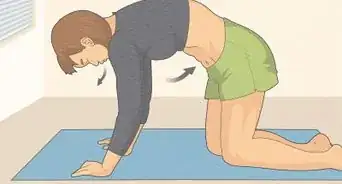
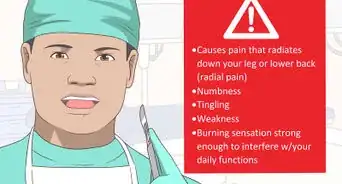


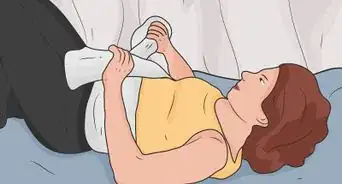


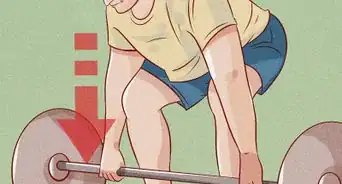
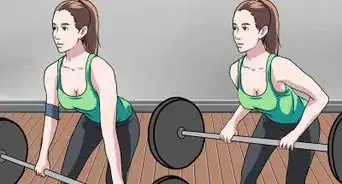









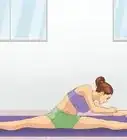
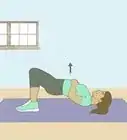





































Medical Disclaimer
The content of this article is not intended to be a substitute for professional medical advice, examination, diagnosis, or treatment. You should always contact your doctor or other qualified healthcare professional before starting, changing, or stopping any kind of health treatment.
Read More...